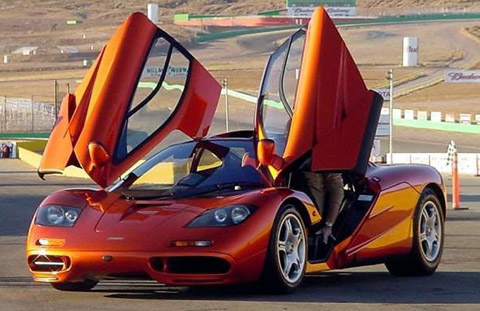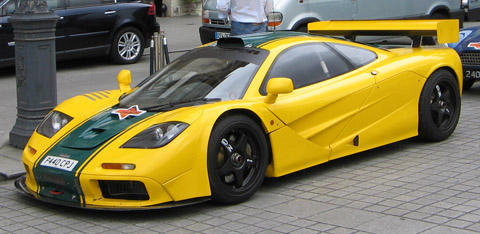

Full disclosure: I blew off my wedding anniversary to drive this thing. And it was totally, 100 percent, without a doubt, worth it.
I realize how this makes me sound. What kind of guy flees the country over his anniversary to drive a supercar? One with a heavy right foot and a love of speed, for starters. But also a guy who reads an assignment email from his editor, temporarily blanks on the fact that his anniversary is the same day as the press launch of the McLaren MP4-12C Spider, and immediately accepts the gig. Hey, I'm only human.
So what did a few days with the 12C Spider, in the south of Spain, on public roads and at the Ascari Race Resort, teach me? That you shouldn't judge a book by its cover. Or by a few reviews.
Supercars are all about numbers, and these are the important ones: For 2013, the 12C's 3.8-liter, twin-turbo V-8 gets a 24-hp bump, for a total of 616 hp. This was accomplished entirely through software tuning; the car's seven-speed, dual-clutch SSG transaxle remains unchanged, though it also benefits from the software update. (All 2012 12Cs will receive the same programming through a dealer service action, which means that roughly 1,700 cars worldwide will be upgraded at no cost to their owners.)
The 12C's carbon-fiber chassis, which McLaren calls a Mono-Cell, was designed from the outset with a convertible version in mind, so no additional strengthening or hardware changes were needed in order to go roofless. That's a very important distinction—amazingly, the Spider's spring rate and shock valving are identical to those of the coupe. The Spider also weighs just 88 pounds more than the coupe, mainly due to its retractable roof panels (constructed from the same lightweight composite as the body) and a new exhaust system. Chiefly, the 12C remains track-day ready, as the chassis incorporates fixed rollover protection behind both driver and passenger.
But if you've read this far, you want to know how the car drives. In a word, brilliantly. Buried behind the numbers, facts, and marketing-speak features is an incredible piece of technology. On the road, with suspension and powertrain left in their least aggressive settings, the ride is supple, the shifts positive yet smooth. For lack of a better term, the McLaren just feels like a car. As with most twin-turbo, small-displacement V-8s, power delivery is a little flat off-boost, but you can easily drive around it. To get the full experience, you click down a few gears, toe-in half throttle to spool up the hair dryers, and then whack it wide open. The car pulls like a train.
There's also launch control, which is both brainless and highly enjoyable: push a few buttons, hold the brake, mash the throttle. Once the instrument-cluster display changes from "building boost" to "release brake," you do just that. Off you go, with tires perfectly hazing themselves and a stupid grin on your face.
Above all, the Spider feels like—and benefits from being—a clean-sheet design. Unlike in a lot of exotics, your feet aren't offset to the right to clear a wheel well. The steering column is centered on your torso, and everything seems intuitive. There is virtually zero cowl shake—this is the first open car I've driven that passes the finger-on-the-door-gap test, where you don't feel panel alignment change as the car moves down the road. In retrospect, it'd probably be a surprise if a McLaren didn't feel like this; the company knows carbon. It used the first carbon chassis in Formula 1, in 1981, and in 1992, it made the first carbon-bodywork, carbon-chassis road car, the legendary F1.
My road time in the 12C Spider took advantage of a few key features, namely the ability to lower the rear window with the top raised, intake sound set to maximum, the suspension in sport mode, and the powertrain in track mode for the most aggressive upshifts and power delivery. It was nothing short of nirvana. At idle you can hear fuel injectors ticking away and faint sounds of machinery at work right behind your head—the air-conditioning compressor cycling, say—but the symphony hits when you mat the throttle. Exhaust, wastegates, pop-off valves, spinning cam chains—at 8,500 rpm, you hear all of it, everything you want. Downshifts are just as fantastic, with revmatching blips and substantial engine braking. There were a few tunnels on the test route. I was juvenile. It was great.
As good as the Spider is on the road, it's best appreciated on a track. The true test of a track car is a driver's comfort level—if you don't feel in control, you simply can't go quickly. With the 12C, this isn't an issue. In full-on track mode, the steering gives impeccable feedback, the optional carbon brakes simply do not fade, and the chassis communicates like a dedicated track car. If you come in too fast and throw too many inputs at the car, it'll wiggle around a little, gently suggesting you calm down. At no point does the Spider become unruly or try to bite you; a quick flick of the wheel or a slight throttle modulation is all you ever need to remain composed at the limit.
Criticisms? Sure, a few. The stock Pirelli P Zero road tires work decently on the track, but the optional Pirelli P Zero Corsa rubber offers a noticeable improvement at 10/10ths. While both tires are a bespoke design developed with Pirelli, the Corsa's more aggressive compound and reduced tread depth are really more suited to the car. The 12C's electronic throttle also suffers from rubbery tip-in and odd, muted modulation. (These days, this is a common problem. I know we can't go back to your foot pushing a mechanical linkage that moves a throttle blade, but you have to hope the industry will eventually sort this out.) And while the McLaren's transaxle works extremely well in its automatic modes, it isn't always intuitive—shifts don't always occur when you expect or want them to, and every so often, the software seems to get confused. The solution in both cases is to just shift it yourself, which is what you really want to do anyway.
One last nit to pick: the active aerodynamics provided by the Spider's airbrake, a rear wing that deploys under hard braking. The car needs the downforce at speed, and the wing works beautifully, but there's a downside. Let's say you notice a vehicle whose government-employed occupant may want to talk to you about the 12C's speed. If you brake hard and try to avoid this conversation, then boom, instant admission of guilt. (It could also be an issue at track events, when you're slowing into a corner; cars behind just disappear.)
If the Lexus LFA was once heralded as the bargain carbon-fiber exotic—in spite of its generally disjointed feel and lackluster-for-a-supercar performance—then the 12C, at more than $100,000 less, must now surely wear that crown. Ferrari's 458 Italia is priced similarly to the McLaren, but it lacks the carbon-fiber-chassis quotient, though many would argue its styling and heritage are bigger draws. Lamborghini's current flagship, the Aventador, offers a 690-hp V-12, but it's far more expensive. It's also half a ton heavier and feels raw in all the wrong ways.
McLaren says its customers drive their cars extensively (one has over 14,000 miles on his so far) and that a large percentage of 12Cs are used on the track. Given how modern supercar buyers seem to be using their cars for more than just running to Anytime Fitness—and how spectacular the 12C is on the track, right out of the box—I'm not surprised. Is this the rebirth of the gentleman racer and the true dual-purpose supercar, a la the Ferrari 250 SWB? You have to hope so.
All else being equal, I see the 12C Spider outselling the coupe simply because there is no downside. The two cars are equally fast and use the same hardware, and the Spider sacrifices no comfort or convenience. Like the fixed-roof 12C, it makes a good driver feel like a great one; more important, it keeps him out of trouble.





















